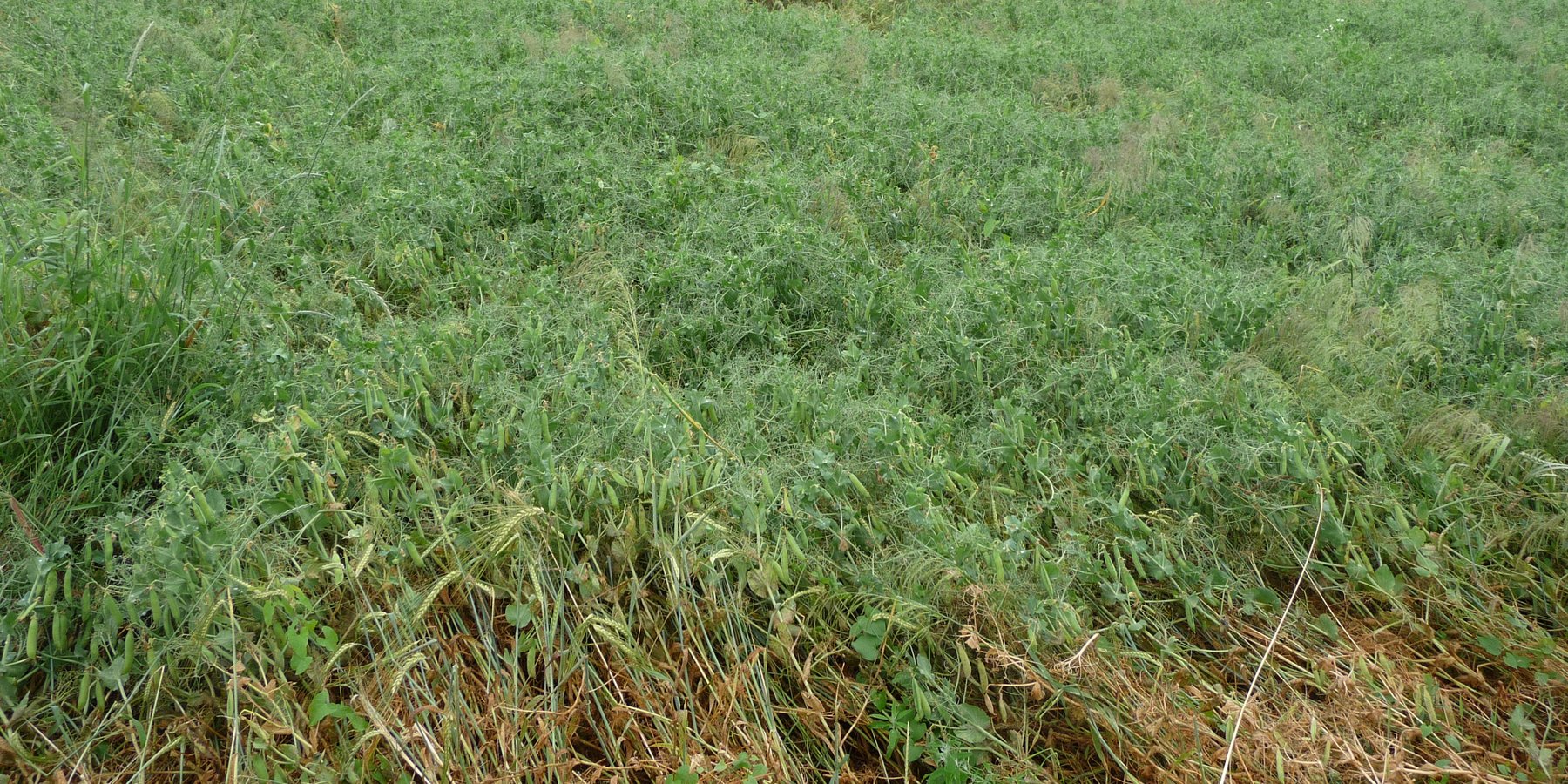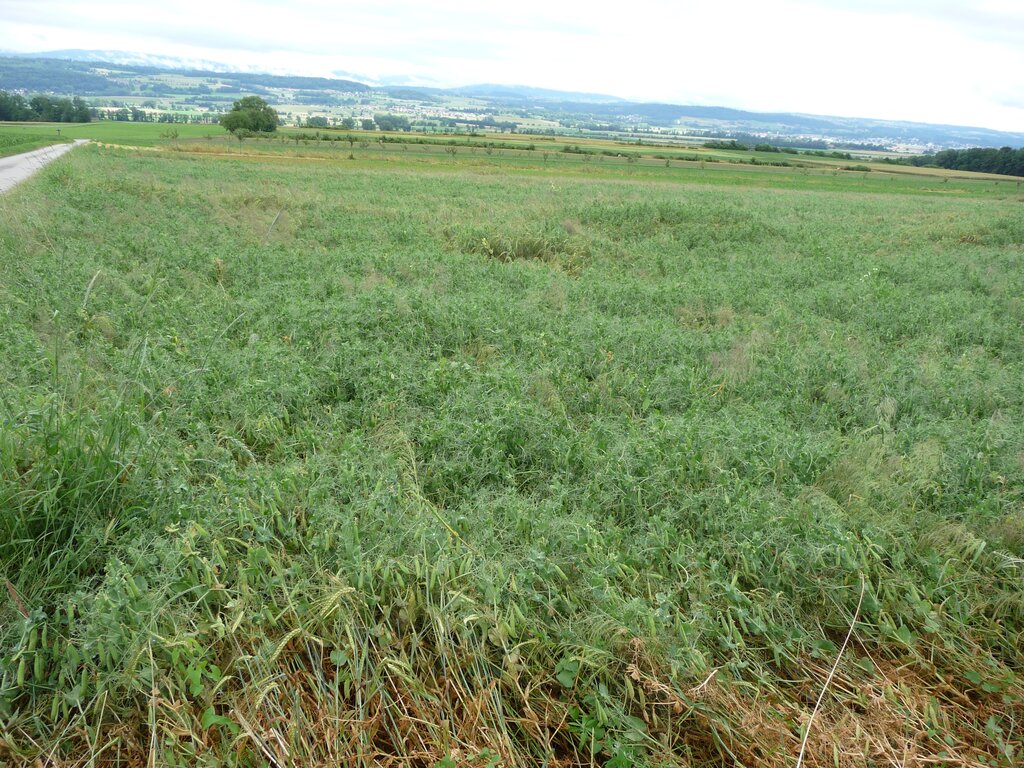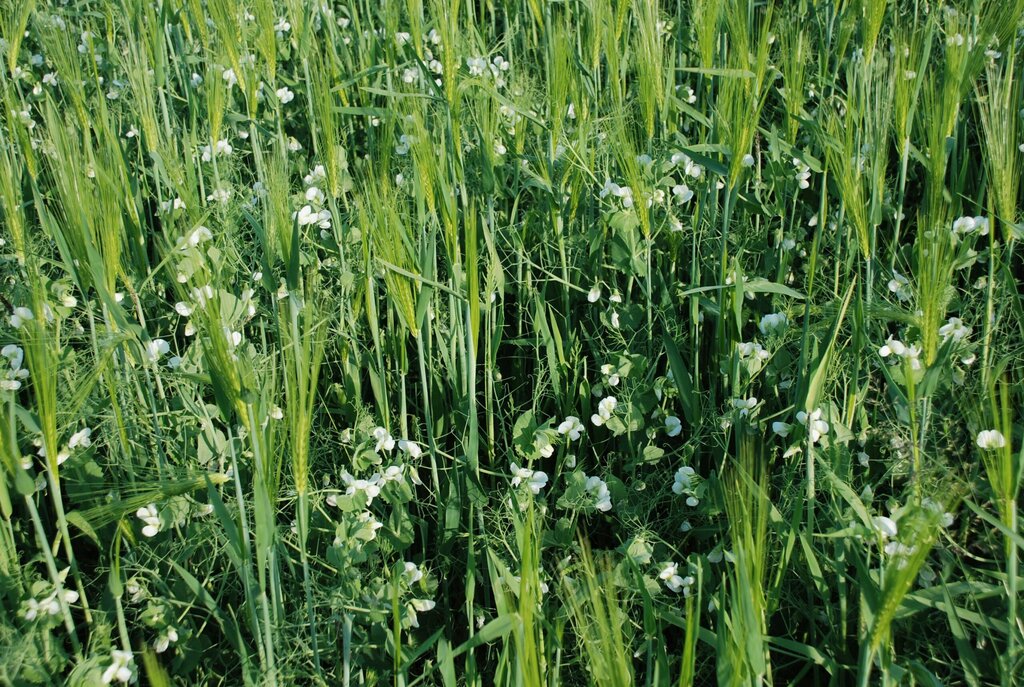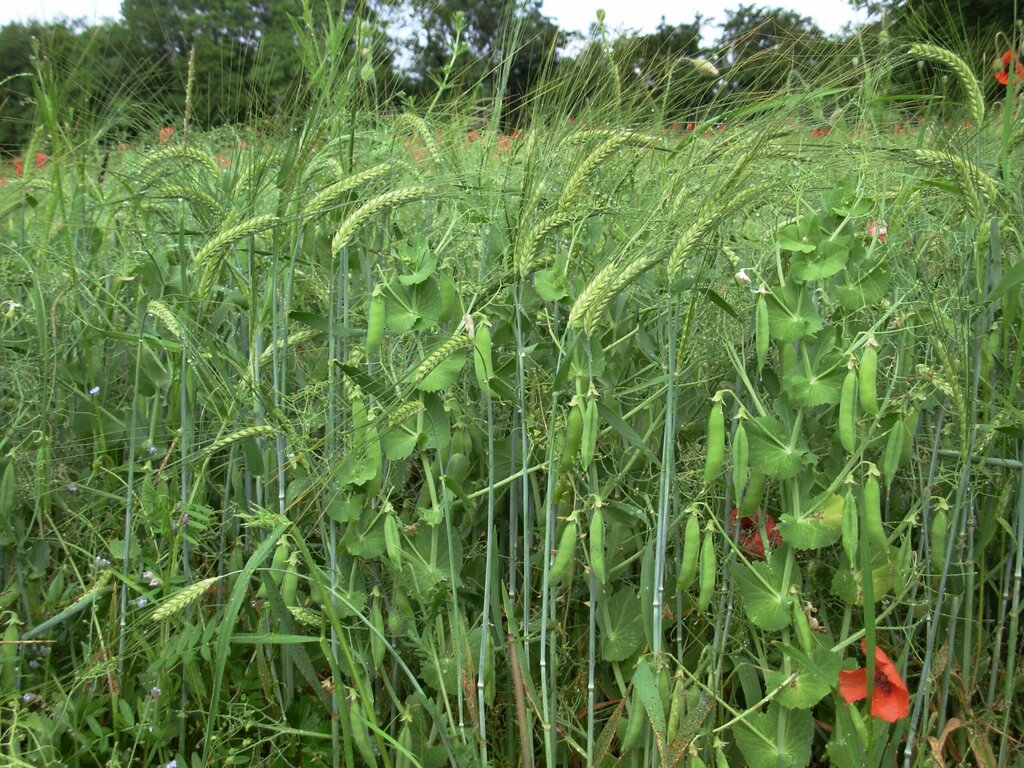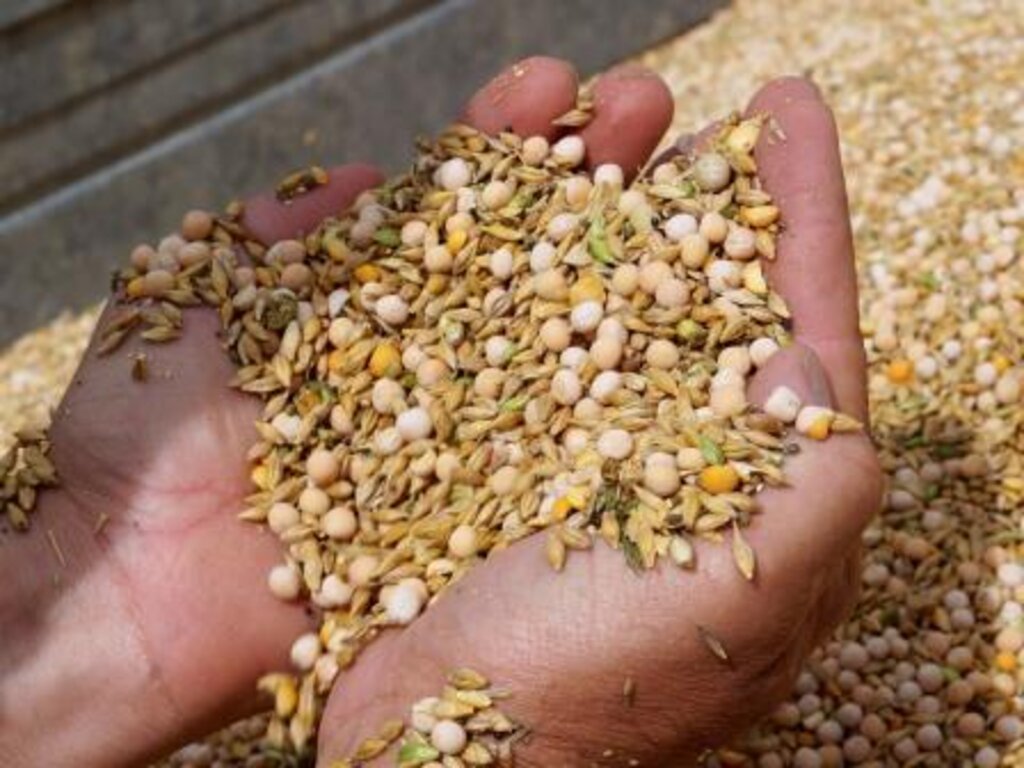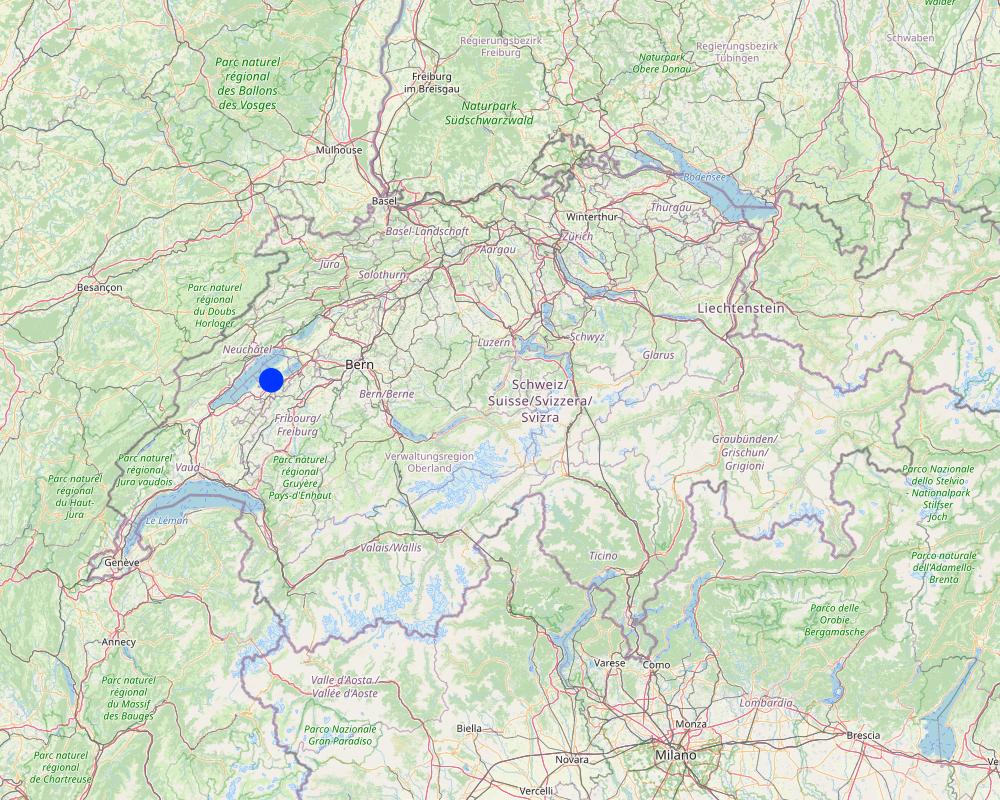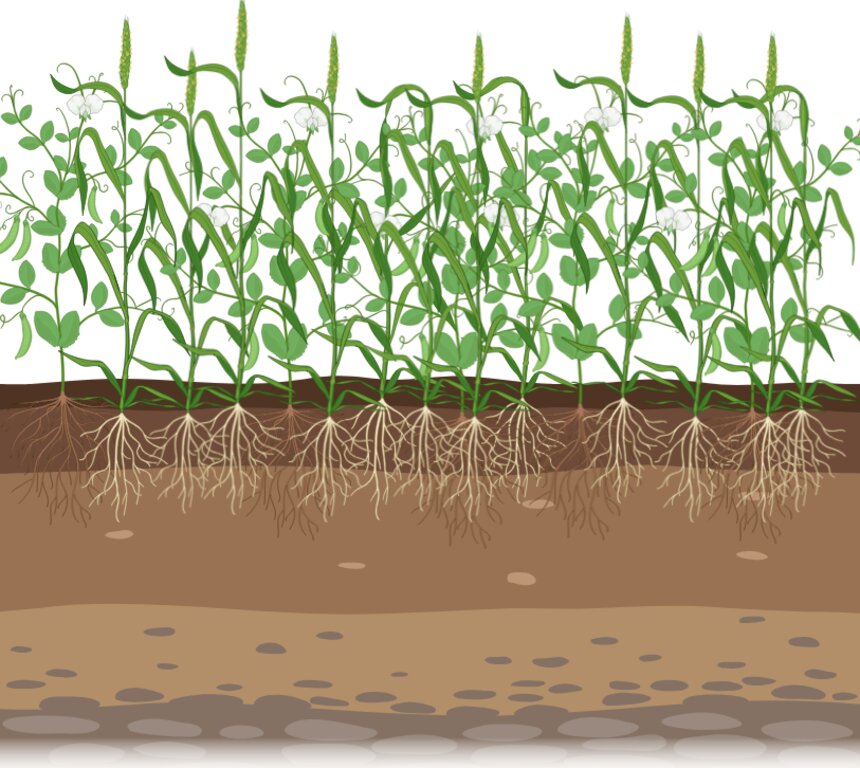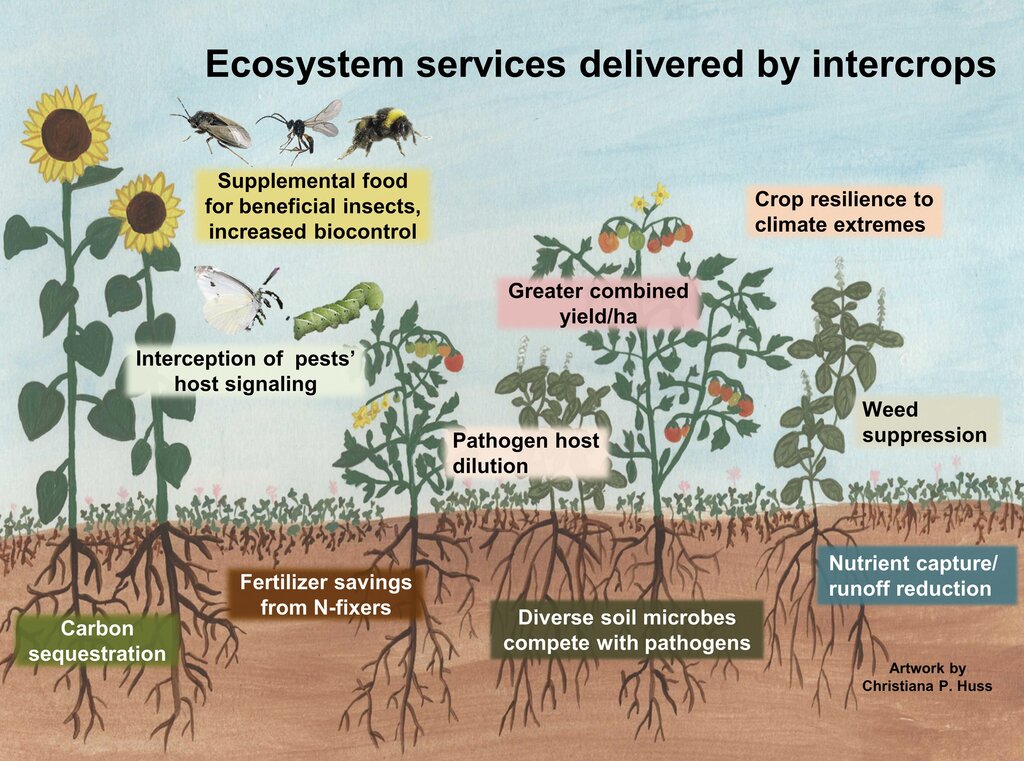Intercropping of grain legumes with cereals [สวิตเซอร์แลนด์]
- ผู้สร้างสรรค์:
- การอัพเดท:
- ผู้รวบรวม: Basile Brunner
- ผู้เรียบเรียง: Maria Eliza Turek, Tatenda Lemann, Joana Eichenberger
- ผู้ตรวจสอบ: William Critchley, Joana Eichenberger
Mischkultur von Körnerleguminosen und Getreide
technologies_6235 - สวิตเซอร์แลนด์
ดูส่วนย่อย
ขยายทั้งหมด ย่อทั้งหมด1. ข้อมูลทั่วไป
1.2 รายละเอียดที่ติดต่อได้ของผู้รวบรวมและองค์กรที่เกี่ยวข้องในการประเมินและการจัดเตรียมทำเอกสารของเทคโนโลยี
วิทยากรหลัก
ผู้ใช้ที่ดิน:
Quillet Lucien
สวิตเซอร์แลนด์
ผู้เชี่ยวชาญ SLM:
Klaiss Matthias
Research Institute of Organic Agriculture FiBL
สวิตเซอร์แลนด์
ชื่อของโครงการซึ่งอำนวยความสะดวกในการทำเอกสารหรือการประเมินเทคโนโลยี (ถ้าเกี่ยวข้อง)
OPtimal strategies to retAIN and re-use water and nutrients in small agricultural catchments across different soil-climatic regions in Europe (OPTAIN)ชื่อขององค์กรซึ่งอำนวยความสะดวกในการทำเอกสารหรือการประเมินเทคโนโลยี (ถ้าเกี่ยวข้อง)
CDE Centre for Development and Environment (CDE Centre for Development and Environment) - สวิตเซอร์แลนด์1.3 เงื่อนไขการใช้ข้อมูลที่ได้บันทึกผ่านทาง WOCAT
ผู้รวบรวมและวิทยากรหลักยอมรับเงื่อนไขเกี่ยวกับการใช้ข้อมูลที่ถูกบันทึกผ่านทาง WOCAT:
ใช่
1.4 การเปิดเผยเรื่องความยั่งยืนของเทคโนโลยีที่ได้อธิบายไว้
เทคโนโลยีที่ได้อธิบายไว้นี้เป็นปัญหาของความเสื่อมโทรมโทรมของที่ดินหรือไม่ จึงไม่ได้รับการยอมรับว่าเป็นเทคโนโลยีเพื่อการจัดการที่ดินอย่างยั่งยืน:
ไม่ใช่
2. การอธิบายลักษณะของเทคโนโลยี SLM
2.1 การอธิบายแบบสั้น ๆ ของเทคโนโลยี
คำจำกัดความของเทคโนโลยี:
Intercropping of grain legumes with cereals is a sustainable agricultural practice in Swiss farming. This involves growing grain legumes (such as peas or beans) alongside cereal crops (like barley or wheat) in the same field, reducing crop failure or yield risk, stabilising the grain legumes, promoting biodiversity and enhancing overall crop yield.
2.2 การอธิบายแบบละเอียดของเทคโนโลยี
คำอธิบาย:
Intercropping of grain legumes with cereals is practised in the Broye catchment area, which covers the cantons of Vaud and Fribourg in Switzerland. The area is characterised by mixed dairy and arable production in the hills and predominantly arable production in the lowlands. The area has an average annual rainfall of 865 mm, an average temperature of 9.6°C and significant agricultural activity relies on irrigation from local rivers.
Intercropping is the simultaneous cultivation of two or more crops in the same field. In this case, grain legumes (such as peas, lupins or faba beans) are grown alongside cereals (such as barley, oats or wheat). The crops are sown together in a pre-prepared mixture, usually at a ratio of 65% legumes to 35% cereals by weight, compared to the standard weight sown in monoculture (100%). The seeds are fully mixed and sown in the same row. Crops are grown over the winter and harvested simultaneously in the spring, which requires compatible combinations whose breeding is continuously optimised for simultaneous ripening. The standard practice in Switzerland is to use a cereal plus a legume.
The main purpose of intercropping grain legumes with cereals is to increase ecological resilience and improve soil fertility. Including legumes in rotations significantly improves soil nitrogen levels, reducing the need for synthetic fertilisers. Intercropping also increases water infiltration, reduces runoff and increases biodiversity. The increase in biodiversity is small in terms of the overall biodiversity of agricultural land (e.g. soil micro-organisms, pollinators). The number of crops grown remains relatively constant. The practice aims to produce higher yields on a given piece of land by using resources that would otherwise not be used by a single crop. The overall yield is higher, although land equivalent ratios (LER) were not measured in this study. However, a cited paper (Chapagain & Riseman, 2014) shows that intercropping barley with peas can increase land productivity by 12-32% compared to monoculture plots, with a 2:1 arrangement producing the highest total land outputs and LER values.
Establishing and maintaining intercropping requires several key activities and inputs: (1) Use of tractors and seed drills for planting and harvesting intercrops. (2) Regular weeding, especially in fields with crops such as soy. (3) Episodic irrigation with water from local irrigation syndicates. (4) Minimal use of fertiliser and homemade manure to maintain soil health.
Intercropping has many benefits: (1) Increases biodiversity, improves soil fertility and increases water infiltration. (2) Reduces the need for synthetic fertilisers, making it economically viable for farmers. (3) Improves drought resistance and reduces the risk of crop failure. (4) Contributes to better water management and resilience to climate change. (5) Surface erosion is reduced by the greater cover of mixed crops (leaf area index).
Farmers appreciate the effectiveness of intercropping in achieving yields similar to monocultures, while adding the benefits of cereals. They also value the reduced need for synthetic fertilisers and improved soil health. However, challenges include seed selection and segregation, particularly for crops such as wheat and faba beans, and weed management in certain fields.
2.3 รูปภาพของเทคโนโลยี
2.5 ประเทศภูมิภาค หรือสถานที่ตั้งที่เทคโนโลยีได้นำไปใช้และได้รับการครอบคลุมโดยการประเมินนี้
ประเทศ:
สวิตเซอร์แลนด์
ภูมิภาค/รัฐ/จังหวัด:
Missy / Vaud / Switzerland
ระบุการกระจายตัวของเทคโนโลยี:
- กระจายไปอย่างสม่ำเสมอในพื้นที่
Is/are the technology site(s) located in a permanently protected area?
ไม่ใช่
Map
×2.6 วันที่การดำเนินการ
ถ้าไม่รู้ปีที่แน่นอน ให้ระบุวันที่โดยประมาณ:
- 10-50 ปี
2.7 คำแนะนำของเทคโนโลยี
ให้ระบุว่าเทคโนโลยีถูกแนะนำเข้ามาอย่างไร:
- ในช่วงการทดลองหรือการทำวิจัย
ความคิดเห็น (ประเภทของโครงการ เป็นต้น) :
Only one farmer was interviewed who practices mixed cropping on 4 ha.
3. การจัดประเภทของเทคโนโลยี SLM
3.1 วัตถุประสงค์หลักของเทคโนโลยี
- ปรับปรุงการผลิตให้ดีขึ้น
- ปรับตัวเข้ากับการเปลี่ยนแปลงภูมิอากาศของโลก สภาพภูมิอากาศที่รุนแรงและผลกระทบ
- สร้างผลกระทบทางด้านเศรษฐกิจที่เป็นประโยชน์
3.2 ประเภทของการใช้ที่ดินในปัจจุบันที่ได้นำเทคโนโลยีไปใช้
Land use mixed within the same land unit:
ไม่ใช่

พื้นที่ปลูกพืช
- การปลูกพืชล้มลุกอายุปีเดียว
Annual cropping - Specify crops:
- cereals - barley
- cereals - oats
- legumes and pulses - other
- legumes and pulses - peas
- Lupine (legume)
จำนวนของฤดูเพาะปลูกต่อปี:
- 1
Is intercropping practiced?
ใช่
If yes, specify which crops are intercropped:
Pea - barley, and lupine - oat
Is crop rotation practiced?
ใช่
ถ้าใช่ ระบุ:
field rotation is as follows: cereals, legumes or maize, cereals, legumes or maize ... And every six years, two successive legumes/maize
3.3 Has land use changed due to the implementation of the Technology?
Has land use changed due to the implementation of the Technology?
- No (Continue with question 3.4)
3.4 การใช้น้ำ
การใช้น้ำของที่ดินที่มีการใช้เทคโนโลยีอยู่:
- น้ำฝนร่วมกับการชลประทาน
แสดงความคิดเห็น:
All the plots on the farm are connected to a stream. The farmer tries to irrigate as little as possible, as it's time consuming and expensive. As there was enough rain this year, there was no need to irrigate the fields.
3.5 กลุ่ม SLM ที่ตรงกับเทคโนโลยีนี้
- การปรับปรุงดิน / พืชคลุมดิน
- การจัดการความอุดมสมบรูณ์ของดินแบบผสมผสาน
- การปรับปรุงพันธุ์พืชหรือพันธุ์สัตว์ต่าง ๆ
3.6 มาตรการ SLM ที่ประกอบกันเป็นเทคโนโลยี

มาตรการจัดการพืช
- A1: พืช/สิ่งปกคลุมดิน
- A2: อินทรียวัตถุในดิน/ความอุดมสมบูรณ์ในดิน
- A5: การจัดการเมล็ดพันธุ์ การปรับปรุงพันธุ์
3.7 รูปแบบหลักของการเสื่อมโทรมของที่ดินที่ได้รับการแก้ไขโดยเทคโนโลยี

การกัดกร่อนของดินโดยน้ำ
- Wt (Loss of topsoil): การสูญเสียดินชั้นบนหรือการกัดกร่อนที่ผิวดิน
3.8 การป้องกัน การลดลง หรือการฟื้นฟูความเสื่อมโทรมของที่ดิน
ระบุเป้าหมายของเทคโนโลยีกับความเสื่อมโทรมของที่ดิน:
- ป้องกันความเสื่อมโทรมของที่ดิน
4. ข้อมูลจำเพาะด้านเทคนิค กิจกรรมการนำไปปฏิบัติใช้ ปัจจัยนำเข้า และค่าใช้จ่าย
4.1 แบบแปลนทางเทคนิคของเทคโนโลยี
ข้อมูลจำเพาะด้านเทคนิค (แบบแปลนทางเทคนิคของเทคโนโลยี):
The illustration shows a field where peas and barley are grown together in a mixed cropping system. The plants with rounded leaves and tendrils are peas, while the taller plants with linear leaves are barley. The interviewed farmer typically grows these crops on an area of two to three hectares. The mixed crops are at an advanced stage of growth, several weeks before harvest, with both pea and barley producing seed. The rooting depth of the pea plants can reach up to 110 centimetres, while the barley plants can extend their roots up to 150 centimetres under optimal conditions.
These plants grow on brown soil composed of three main horizons. Horizon A is usually brownish in colour and extends to a depth of over 20 cm. It is rich in organic matter and mineral particles, making it biologically active with many soil organisms and plant roots. The B horizon is lighter in colour and typically extends from about 20 cm to 150 cm deep. It contains minerals leached from the A horizon and shows signs of weathering, with a more defined structure due to the accumulation of minerals and organic matter from the upper layers. The C horizon, or parent material, lies below the B horizon and extends beyond 150 cm. It consists of partially disintegrated and weathered parent material, is typically lighter in colour than the B horizon and has minimal biological activity compared to the upper layers.
ผู้เขียน:
Basile Brunner (UniBE)
วันที่:
15/08/2024
ข้อมูลจำเพาะด้านเทคนิค (แบบแปลนทางเทคนิคของเทคโนโลยี):
llustration of benefits of intercropping for crop resilience and crop yields, management of soils, weeds, pests, and pathogens, along with environmental benefits of carbon sequestration and reduction of fossil fuel inputs.
ผู้เขียน:
Christiana Huss
วันที่:
22/04/2022
4.2 ข้อมูลทั่วไปเกี่ยวกับการคำนวณปัจจัยนำเข้าและค่าใช้จ่าย
ให้ระบุว่าค่าใช้จ่ายและปัจจัยนำเข้าได้รับการคำนวณอย่างไร:
- ต่อพื้นที่ที่ใช้เทคโนโลยี
ระบุขนาดและหน่วยพื้นที่:
ha
อื่นๆ หรือสกุลเงินประจำชาติ (ระบุ):
CHF
If relevant, indicate exchange rate from USD to local currency (e.g. 1 USD = 79.9 Brazilian Real): 1 USD =:
1.13
ระบุค่าเฉลี่ยของค่าจ้างในการจ้างแรงงานต่อวัน:
240 CHF
4.5 การบำรุงรักษาสภาพหรือกิจกรรมที่เกิดขึ้นเป็นประจำ
| กิจกรรม | ช่วงระยะเวลา/ความถี่ | |
|---|---|---|
| 1. | Mixing seeds: For single tank seeders, mix seeds at a ratio of 80% peas and 40% barley. For multi-tank seeders, apply seeds of mixture partners separately. | Before sowing, typically in late summer. |
| 2. | Sowing: Use a row spacing of 12 cm, and place seeds at a depth of 3 to 4 cm. | late october |
| 3. | Assess the mix’s condition after winter. | Spring, depending on winter severity. |
| 4. | Weed Control: Generally not needed due to the competitive nature of the mixed crop. If high weed pressure: Consider harrowing once (2-3 hours per hectare for weeding). | Spring, depending on winter severity. |
| 5. | Harvesting: Adjust harvester sieves for peas. Open threshing concave and hulling bars wide. Maintain low drum rotation. Monitor for grain loss regularly. Adjust Vario-table to an aggressive cutting angle. | Summer. |
แสดงความคิดเห็น:
Maintenance activities for a mixed intercropping culture of winter peas/barley.
Cultivate the mixed crop only every seventh year in crop rotation. Avoid growing lupins, vetches, lucerne, or pure stands of red clover in between. No nitrogen fertilisation. Irrigation only in very dry years.
4.6 ค่าใช้จ่ายของปัจจัยนำเข้าและกิจกรรมที่เกิดขึ้นเป็นประจำที่ต้องการการบำรุงรักษา (ต่อปี)
| ปัจจัยนำเข้า | หน่วย | ปริมาณ | ค่าใช้จ่ายต่อหน่วย | ค่าใช้จ่ายทั้งหมดต่อปัจจัยนำเข้า | %ของค่าใช้จ่ายที่ก่อให้เกิดขึ้นโดยผู้ใช้ที่ดิน | |
|---|---|---|---|---|---|---|
| แรงงาน | Ploughing | person-days | 1.0 | 200.0 | 200.0 | 100.0 |
| แรงงาน | Sowing the Mixture | person-days | 1.0 | 200.0 | 200.0 | 100.0 |
| แรงงาน | Weeding | person-hours | 3.0 | 23.0 | 69.0 | 100.0 |
| อุปกรณ์ | seeder | piece | 1.0 | 10000.0 | 10000.0 | 100.0 |
| อุปกรณ์ | tractor | piece | 1.0 | 30000.0 | 30000.0 | 100.0 |
| อุปกรณ์ | harvester | piece | 1.0 | 15000.0 | 15000.0 | 100.0 |
| อุปกรณ์ | plough | piece | 1.0 | 15000.0 | 15000.0 | 100.0 |
| วัสดุด้านพืช | Seed mixture protein peas / barley mixture (autumn sowing) organic | kg/ha | 200.0 | 6.0 | 1200.0 | 100.0 |
| ค่าใช้จ่ายทั้งหมดของการบำรุงรักษาสภาพเทคโนโลยี | 71669.0 | |||||
| Total costs for maintenance of the Technology in USD | 63423.89 | |||||
แสดงความคิดเห็น:
Normal machinery (tractor, seeder, harvester) can be used. In many cases it is already available on the farm.
Weed control is usually not needed. If there is high weed pressure, harrow or hoe it once.
No nitrogen fertilising for the crop. Irrigation would only be needed in an extremely dry year.
In order to avoid legume fatigue in the soil, only cultivate the mixed crop every seventh year. Also do not grow lupins, vetches, Lucerne or pure stands of red clover in between.
4.7 ปัจจัยสำคัญที่สุดที่มีผลกระทบต่อค่าใช้จ่าย
ปัจจัยสำคัญที่สุดที่มีผลกระทบต่อค่าใช้จ่ายต่างๆ:
No exceptional investments are needed as existing machines are used.
The cost of seeds and the seed sorting costs by the mills.
Time and labour required for weeding, which can vary based on crop type.
The demand and price for the crops grown. E.g. soy having higher demand and price compared to peas.
5. สิ่งแวดล้อมทางธรรมชาติและของมนุษย์
5.1 ภูมิอากาศ
ฝนประจำปี
- < 250 ม.ม.
- 251-500 ม.ม.
- 501-750 ม.ม.
- 751-1,000 ม.ม.
- 1,001-1,500 ม.ม.
- 1,501-2,000 ม.ม.
- 2,001-3,000 ม.ม.
- 3,001-4,000 ม.ม.
- > 4,000 ม.ม.
ระบุปริมาณน้ำฝนเฉลี่ยรายปี (ถ้ารู้) :หน่วย ม.ม.
865.00
ระบุชื่อของสถานีตรวดวัดอากาศที่ใช้อ้างอิงคือ:
Payerne
เขตภูมิอากาศเกษตร
- กึ่งชุ่มชื้น
average maximum temperature 14.2°C, average minimum temperature 5.1°C
5.2 สภาพภูมิประเทศ
ค่าเฉลี่ยความลาดชัน:
- ราบเรียบ (0-2%)
- ลาดที่ไม่ชัน (3-5%)
- ปานกลาง (6-10%)
- เป็นลูกคลื่น (11-15%)
- เป็นเนิน (16-30%)
- ชัน (31-60%)
- ชันมาก (>60%)
ธรณีสัณฐาน:
- ที่ราบสูง/ที่ราบ
- สันเขา
- ไหล่เขา
- ไหล่เนินเขา
- ตีนเนิน
- หุบเขา
ระดับความสูง:
- 0-100 เมตร
- 101-500 เมตร
- 501-1,000 เมตร
- 1,001-1,500 เมตร
- 1,501-2,000 เมตร
- 2,001-2,500 เมตร
- 2,501-3,000 เมตร
- 3,001-4,000 เมตร
- > 4,000 เมตร
ให้ระบุถ้าเทคโนโลยีได้ถูกนำไปใช้:
- ไม่เกี่ยวข้อง
5.3 ดิน
ค่าเฉลี่ยความลึกของดิน:
- ตื้นมาก (0-20 ซ.ม.)
- ตื้น (21-50 ซ.ม.)
- ลึกปานกลาง (51-80 ซ.ม.)
- ลึก (81-120 ซ.ม.)
- ลึกมาก (>120 ซ.ม.)
เนื้อดิน (ดินชั้นบน):
- ละเอียด/หนัก (ดินเหนียว)
เนื้อดินล่าง (> 20 ซ.ม.ต่ำจากผิวดิน):
- ละเอียด/หนัก (ดินเหนียว)
อินทรียวัตถุในดิน:
- ปานกลาง (1-3%)
5.4 ความเป็นประโยชน์และคุณภาพของน้ำ
ระดับน้ำใต้ดิน:
<5 เมตร
น้ำไหลบ่าที่ผิวดิน:
ดี
คุณภาพน้ำ (ที่ยังไม่ได้บำบัด):
เป็นน้ำใช้เพื่อการเกษตรเท่านั้น (การชลประทาน)
Water quality refers to:
surface water
ความเค็มของน้ำเป็นปัญหาหรือไม่:
ไม่ใช่
กำลังเกิดน้ำท่วมในพื้นที่หรือไม่:
ใช่
บ่อยครั้ง:
เป็นครั้งเป็นคราว
ความคิดเห็นและข้อมูลจำเพาะเพิ่มเติมเรื่องคุณภาพและปริมาณน้ำ:
The increasing threat of heavy rainfall events due to climate change enhances the threat of flooding.
5.5 ความหลากหลายทางชีวภาพ
ความหลากหลายทางชนิดพันธุ์:
- ปานกลาง
ความหลากหลายของแหล่งที่อยู่:
- ต่ำ
ความคิดเห็นและข้อมูลจำเพาะเพิ่มเติมของความหลากหลายทางชีวภาพ:
Both are in between low and medium, but rather low.
5.6 ลักษณะของผู้ใช้ที่ดินที่นำเทคโนโลยีไปปฏิบัติใช้
อยู่กับที่หรือเร่ร่อน:
- อยู่กับที่
แนวทางการตลาดของระบบการผลิต:
- ทำการค้า/การตลาด
รายได้ที่มาจากนอกฟาร์ม:
- < 10% ของรายได้ทั้งหมด
ระดับของความมั่งคั่งโดยเปรียบเทียบ:
- พอมีพอกิน
เป็นรายบุคคล/ครัวเรือน:
- เป็นรายบุคคล/ครัวเรือน
ระดับของการใช้เครื่องจักรกล:
- การใช้เครื่องจักรหรือเครื่องยนต์
เพศ:
- หญิง
- ชาย
อายุของผู้ใช้ที่ดิน:
- วัยกลางคน
5.7 Average area of land used by land users applying the Technology
- < 0.5 เฮกตาร์
- 0.5-1 เฮกตาร์
- 1-2 เฮกตาร์
- 2-5 เฮกตาร์
- 5-15 เฮกตาร์
- 15-50 เฮกตาร์
- 50-100 เฮกตาร์
- 100-500 เฮกตาร์
- 500-1,000 เฮกตาร์
- 1,000-10,000 เฮกตาร์
- >10,000 เฮกตาร์
พิจารณาว่าเป็นขนาดเล็ก กลาง หรือขนาดใหญ่ (ซึ่งอ้างอิงถึงบริบทระดับท้องถิ่น):
- ขนาดใหญ่
แสดงความคิดเห็น:
The Swiss average of agricultural area per farm is 20.9 ha. In the Broye region, it is 31.65 ha.
5.8 กรรมสิทธิ์ในที่ดิน สิทธิในการใช้ที่ดินและสิทธิในการใช้น้ำ
กรรมสิทธิ์ในที่ดิน:
- รายบุคคล ได้รับสิทธิครอบครอง
สิทธิในการใช้ที่ดิน:
- รายบุคคล
สิทธิในการใช้น้ำ:
- เกี่ยวกับชุมชน (ถูกจัดระเบียบ)
Are land use rights based on a traditional legal system?
ไม่ใช่
5.9 การเข้าถึงบริการและโครงสร้างพื้นฐาน
สุขภาพ:
- จน
- ปานกลาง
- ดี
การศึกษา:
- จน
- ปานกลาง
- ดี
ความช่วยเหลือทางด้านเทคนิค:
- จน
- ปานกลาง
- ดี
การจ้างงาน (เช่น ภายนอกฟาร์ม):
- จน
- ปานกลาง
- ดี
ตลาด:
- จน
- ปานกลาง
- ดี
พลังงาน:
- จน
- ปานกลาง
- ดี
ถนนและการขนส่ง:
- จน
- ปานกลาง
- ดี
น้ำดื่มและการสุขาภิบาล:
- จน
- ปานกลาง
- ดี
บริการด้านการเงิน:
- จน
- ปานกลาง
- ดี
6. ผลกระทบและสรุปคำบอกกล่าว
6.1 ผลกระทบในพื้นที่ดำเนินการ (On-site) จากการใช้เทคโนโลยี
ผลกระทบทางด้านเศรษฐกิจและสังคม
การผลิต
การผลิตพืชผล
แสดงความคิดเห็น/ระบุ:
Higher land use ratio (more biomass per hectare).
คุณภาพพืชผล
แสดงความคิดเห็น/ระบุ:
Cereals in the mixture prevent weeds from spreading within the legumes. But cereals (e.g. barley) of a lower quality than if they were grown in a monoculture.
การเสี่ยงต่อความล้มเหลวในการผลิต
แสดงความคิดเห็น/ระบุ:
If legumes are not growing well, fertiliser can be added and cereals can be harvested.
ความหลากหลายของผลิตภัณฑ์
แสดงความคิดเห็น/ระบุ:
The same products are harvested as in a monoculture, but at the same time.
พื้นที่สำหรับการผลิต
การจัดการที่ดิน
แสดงความคิดเห็น/ระบุ:
Less intervention (e.g. weeding, fertilisation) required.
ความเป็นประโยชน์และคุณภาพของน้ำ
ความต้องการน้ำจากการชลประทาน
แสดงความคิดเห็น/ระบุ:
Water demand remains approximately the same as in monoculture.
รายได้และค่าใช้จ่าย
ค่าใช่จ่ายของปัจจัยการผลิตทางการเกษตร
แสดงความคิดเห็น/ระบุ:
Reduced expenditure on organic crop protection & weeding thanks to cereals' positive effect on weed control (compared to legume monoculture).
รายได้จากฟาร์ม
แสดงความคิดเห็น/ระบุ:
As mixed cropping can be used within the crop rotation, it only leads to a slight increase in the farmer's income.
ความหลากหลายของแหล่งผลิตรายได้
แสดงความคิดเห็น/ระบุ:
The same crops are cultivated as in monoculture.
ภาระงาน
แสดงความคิดเห็น/ระบุ:
Less intervention (e.g. weeding) required as cereals protect legumes from weeds and legumes provide nitrogen to cereals.
ผลกระทบด้านนิเวศวิทยา
วัฐจักรน้ำหรือน้ำบ่า
การระเหย
แสดงความคิดเห็น/ระบุ:
Good soil cover due to mixed cultivation slightly reduces evaporation.
ดิน
สิ่งปกคลุมดิน
การหมุนเวียนและการเติมของธาตุอาหาร
แสดงความคิดเห็น/ระบุ:
Legumes fix nitrogen in the soil.
ความเค็ม
ความเป็นกรด
ความหลากหลายทางชีวภาพของพืชและสัตว์
การปกคลุมด้วยพืช
แสดงความคิดเห็น/ระบุ:
Slightly higher due to mixed species.
มวลชีวภาพ/เหนือดินชั้น C
แสดงความคิดเห็น/ระบุ:
slightly higher because of species mixture
ความหลากหลายทางชีวภาพของพืช
แสดงความคิดเห็น/ระบุ:
Slightly higher due to mixed species.
พืชพันธุ์ต่างถิ่นที่รุกล้ำเข้ามา
แสดงความคิดเห็น/ระบุ:
Slightly less due to weed suppression in cereals.
ชนิดพันธุ์ที่ให้ประโยชน์
แสดงความคิดเห็น/ระบุ:
Legumes provide flowers for pollinators.
6.2 ผลกระทบนอกพื้นที่ดำเนินการ (Off-site) จากการใช้เทคโนโลยี
ตะกอนที่ถูกพัดพามาโดยลม
6.3 การเผชิญและความตอบสนองของเทคโนโลยีต่อการเปลี่ยนแปลงสภาพภูมิอากาศที่ค่อยเป็นค่อยไป และสภาพรุนแรงของภูมิอากาศ / ภัยพิบัติ (ที่รับรู้ได้โดยผู้ใช้ที่ดิน)
การเปลี่ยนแปลงสภาพภูมิอากาศที่ค่อยเป็นค่อยไป
การเปลี่ยนแปลงสภาพภูมิอากาศที่ค่อยเป็นค่อยไป
| ฤดู | increase or decrease | เทคโนโลยีมีวิธีการรับมืออย่างไร | |
|---|---|---|---|
| อุณหภูมิตามฤดูกาล | ฤดูใบไม้ผลิ | เพิ่มขึ้น | ดีมาก |
| อุณหภูมิตามฤดูกาล | ฤดูร้อน | เพิ่มขึ้น | ดี |
| อุณหภูมิตามฤดูกาล | ฤดูใบไม้ร่วง | เพิ่มขึ้น | ดี |
| อุณหภูมิตามฤดูกาล | ฤดูหนาว | เพิ่มขึ้น | ดีมาก |
| ฝนตามฤดู | ฤดูใบไม้ผลิ | เพิ่มขึ้น | ดี |
| ฝนตามฤดู | ฤดูร้อน | ลดลง | ไม่ค่อยดี |
| ฝนตามฤดู | ฤดูใบไม้ร่วง | ลดลง | ปานกลาง |
| ฝนตามฤดู | ฤดูหนาว | เพิ่มขึ้น | ดี |
สภาพรุนแรงของภูมิอากาศ (ภัยพิบัติ)
ภัยพิบัติทางอุตุนิยมวิทยา
| เทคโนโลยีมีวิธีการรับมืออย่างไร | |
|---|---|
| พายุฝนฟ้าคะนองประจำท้องถิ่น | ดี |
| พายุลูกเห็บประจำท้องถิ่น | ปานกลาง |
ภัยพิบัติจากสภาพภูมิอากาศ
| เทคโนโลยีมีวิธีการรับมืออย่างไร | |
|---|---|
| คลื่นความร้อน | ปานกลาง |
| คลื่นความหนาว | ดี |
| ภัยจากฝนแล้ง | ไม่ค่อยดี |
ภัยพิบัติทางชีวภาพ
| เทคโนโลยีมีวิธีการรับมืออย่างไร | |
|---|---|
| โรคระบาด | ดี |
แสดงความคิดเห็น:
In a very dry summer with limited irrigation, competition for water availability between the two species in the mix can lead to poor crop quality at harvest.
In the event of a very cold winter and poor legume growth, the technology has the advantage of allowing the farmer to apply fertiliser and still harvest cereals at the end of the season, reducing the risk of crop failure.
6.4 การวิเคราะห์ค่าใช้จ่ายและผลประโยชน์ที่ได้รับ
ผลประโยชน์ที่ได้รับเปรียบเทียบกับค่าใช้จ่ายในการจัดตั้งเป็นอย่างไร (จากมุมมองของผู้ใช้ที่ดิน)
ผลตอบแทนระยะสั้น:
ด้านบวก
ผลตอบแทนระยะยาว:
ด้านบวก
ผลประโยชน์ที่ได้รับเปรียบเทียบกับค่าใช้จ่ายในการบำรุงรักษาหรือต้นทุนที่เกิดขึ้นซ้ำอีก เป็นอย่างไร (จากมุมมองของผู้ใช้ที่ดิน)
ผลตอบแทนระยะสั้น:
ด้านบวกเล็กน้อย
ผลตอบแทนระยะยาว:
ด้านบวกเล็กน้อย
6.5 การปรับตัวของเทคโนโลยี
- 1-10%
Of all those who have adopted the Technology, how many did so spontaneously, i.e. without receiving any material incentives/ payments?
- 11-50%
6.6 การปรับตัว
เทคโนโลยีได้รับการปรับเปลี่ยนเมื่อเร็วๆนี้ เพื่อให้ปรับตัวเข้ากับสภาพที่กำลังเปลี่ยนแปลงหรือไม่:
ใช่
ถ้าตอบว่าใช่ ให้ระบุว่าเงื่อนไขการเปลี่ยนแปลงใดที่ถูกปรับตัว:
- การเปลี่ยนแปลงของตลาด
ให้ระบุการปรับตัวของเทคโนโลยี (การออกแบบ วัสดุหรือชนิดพันธุ์ เป็นต้น):
Decrease for market reasons (barley has low market price) & more adapted varieties (pea varieties that are more resistant to wind damage).
6.7 จุดแข็ง / ข้อได้เปรียบ / โอกาสของเทคโนโลยี
| จุดแข็ง / ข้อได้เปรียบ / โอกาสในทัศนคติของผู้ใช้ที่ดิน |
|---|
| Mixed cropping works very well, providing both legume and cereal yields. |
| Certain crops, like oats, help suppress weeds, reducing the need for additional weeding. Thus saving costs (PPPs & labour) and reducing workload (hours of weeding). |
| Legumes contribute to nitrogen fixation, improving soil fertility for subsequent crops. |
| Mixed cropping reduces the risk of total crop failure, as one crop can compensate if the other underperforms. |
| จุดแข็ง / ข้อได้เปรียบ / โอกาสในทัศนคติของผู้รวบรวมหรือวิทยากรหลัก |
|---|
| If one crop fails, the other can still provide a harvest, ensuring some yield. |
| Mixed cropping can produce more biomass on the same land compared to monocultures. |
| It enhances soil diversity, supports pollinators, and contributes to nitrogen enrichment. |
| Good market price for protein peas. Additionally, the farmer receives a subsidy for grain legumes (including protein peas), if the harvest contains at least 30% grain legume seeds. In addition, the cantons of Jura and Vaud pay cantonal contributions to farmers who cultivate mixed crops. The farmers can also get extra payments by the organic farmer organisation Bio Suisse if certain grain legume species of high demand are cultivated (see Agridea Deckungsbeitrag catalogue for more information). |
6.8 จุดอ่อน / ข้อเสียเปรียบ / ความเสี่ยงของเทคโนโลยีและวิธีการแก้ไข
| จุดอ่อน / ข้อเสียเปรียบ / ความเสี่ยงในทัศนคติของผู้ใช้ที่ดิน | มีวิธีการแก้ไขได้อย่างไร |
|---|---|
| Legumes are not growing well due to a cold winter. | Adding fertilizer can help growing the cereal and enables the farmer to still harvest something. |
| Water competition in a dry summer results in a bad crop quality. | Ensure efficient irrigation to reduce competition for water between mixed crops. |
| Barley has a very low market value. | Choose crop varieties that are better adapted to market demands. |
| จุดอ่อน / ข้อเสียเปรียบ / ความเสี่ยงในทัศนคติของผู้รวบรวมหรือวิทยากรหลัก | มีวิธีการแก้ไขได้อย่างไร |
|---|---|
| During drought stress, competition for water between the two crops can occur, leading to potential yield losses or low quality yield. | Use drought-tolerant varieties or species with deep roots for mixed cropping. This can help reduce competition for water and improve resilience during dry periods. |
| Limited market demand for certain crops like barley. | Focus on crops with higher market demand. |
| Need for minimal fertilization in mixed cropping can reduce yield quality of cereals like barley. | Implement targeted fertilization strategies to balance the needs of both crops. |
7. การอ้างอิงและการเชื่อมต่อ
7.1 วิธีการและแหล่งข้อมูล
- ไปเยี่ยมชมภาคสนาม การสำรวจพื้นที่ภาคสนาม
1 field visit to Missy, Canton of Vaud, Switzerland
- การสัมภาษณ์กับผู้ใช้ที่ดิน
1 interview with farmer Lucien Quillet
- การสัมภาษณ์ผู้เชี่ยวชาญด้าน SLM หรือผู้ชำนาญ
1 interview with researcher Matthias Klaiss (FiBL)
- การเก็บรวบรวมมาจากรายงานและเอกสารที่มีอยู่
Various written sources were used, with FiBL fact sheets being particularly informative for this context.
วันที่เก็บรวบรวมข้อมูล(ภาคสนาม) :
08/07/2024
7.2 การอ้างอิงถึงสิ่งตีพิมพ์
หัวข้อ, ผู้เขียน, ปี, หมายเลข ISBN:
Huss, C. P., Holmes, K. D., & Blubaugh, C. K. (2022). Benefits and risks of intercropping for crop resilience and pest management. Journal of Economic Entomology, 115(5), 1350–1362. https://doi.org/10.1093/jee/toac045
หัวข้อ, ผู้เขียน, ปี, หมายเลข ISBN:
Klaiss, M. (2021). Intercropping of grain pea with cereals (Legumes Translated Practice Note 17, S. 1–4). Institute of Organic Agriculture FiBL. https://orgprints.org/id/eprint/42384/
หัวข้อ, ผู้เขียน, ปี, หมายเลข ISBN:
Alföldi, T., Haug, B., Messmer, M., Goldringer, I., Forst, E., Mary-Huard, T., Enjalbert, J., & Hohmann, P. (2020). Mischkulturen Erbsen/Gerste - Braucht es eine eigene Züchtung? EU-Projekt ReMIX (Video). Forschungsinstitut für biologischen Landbau FiBL, CH-Frick. Retrieved 31 July, 2024, from https://orgprints.org/id/eprint/37276/
หัวข้อ, ผู้เขียน, ปี, หมายเลข ISBN:
Haug, B., Messmer, M., Enjalbert, J., Goldringer, I., Flutre, T., Mary-Huard, T., & Hoh-mann, P. (2023). New insights towards breeding for mixed cropping of spring pea and bar-ley to increase yield and yield stability. Field Crops Research, 297, 108923. https://doi.org/10.1016/j.fcr.2023.108923
หัวข้อ, ผู้เขียน, ปี, หมายเลข ISBN:
Hiltbrunner J., Wüst S., Blatter A., Vonzun S., Klaiss M., Messmer M. (2023). Optimierung des Mischkultursystems Erbse-Gerste zur Sicherung der lokalen Eiweissversorgung. Feld-rundgänge & Präsentation Projekt PROMISE 2023. Agroscope. Stiegenhof, Arenenberg, Utzenstorf & Sargans. https://ira.agroscope.ch/de-CH/publication/53643
หัวข้อ, ผู้เขียน, ปี, หมายเลข ISBN:
Vonzun S., Blatter A., Wüst S., Hiltbrunner J., Schneider M., Messmer M. (2023). Investi-gating mixed cropping systems with pea and lentils for climate-smart and demand oriented agriculture. Fourth International Legume Society Conference 2023. 19 September, Granada. https://ira.agroscope.ch/de-CH/publication/55455
7.3 Links to relevant online information
ชื่อเรื่องหรือคำอธิบาย:
Research Institute of Organic Agriculture FiBL. (2017). Erfolgreicher Anbau von Körnerleguminosen in Mischkultur mit Getreide.
URL:
https://www.fibl.org/en/shop-en/1670-koernerleguminosen-mischkulturen
ชื่อเรื่องหรือคำอธิบาย:
FiBLFilm. (2020, May 6). Increasing domestic protein supply with intercropping - Diverimpacts success story from Switzerland [Video file].
URL:
https://www.youtube.com/watch?v=BadrJW-b_2g
ชื่อเรื่องหรือคำอธิบาย:
FiBLFilm. (2015, September 29). Anbau von Mischkulturen (Colture consociate) - Körnerleguminosen Getreide [Video file].
URL:
https://www.youtube.com/watch?v=gAYNXCw2CiE
ชื่อเรื่องหรือคำอธิบาย:
Research Institute of Organic Agriculture FiBL. (2024). FiBL projects Grain legumes intercropped with cereals and other partners.
URL:
https://www.fibl.org/de/themen/huelsenfruechte/huelsenfruechte-projekte
ชื่อเรื่องหรือคำอธิบาย:
Research Institute of Organic Agriculture FiBL. (2024). Deckungsbeiträge. Praxispublikationen.
URL:
https://www.fibl.org/de/shop/1104-deckungsbeitraege
ลิงก์และโมดูล
ขยายทั้งหมด ย่อทั้งหมดลิงก์
ไม่มีลิงก์
โมดูล
ไม่มีโมดูล


